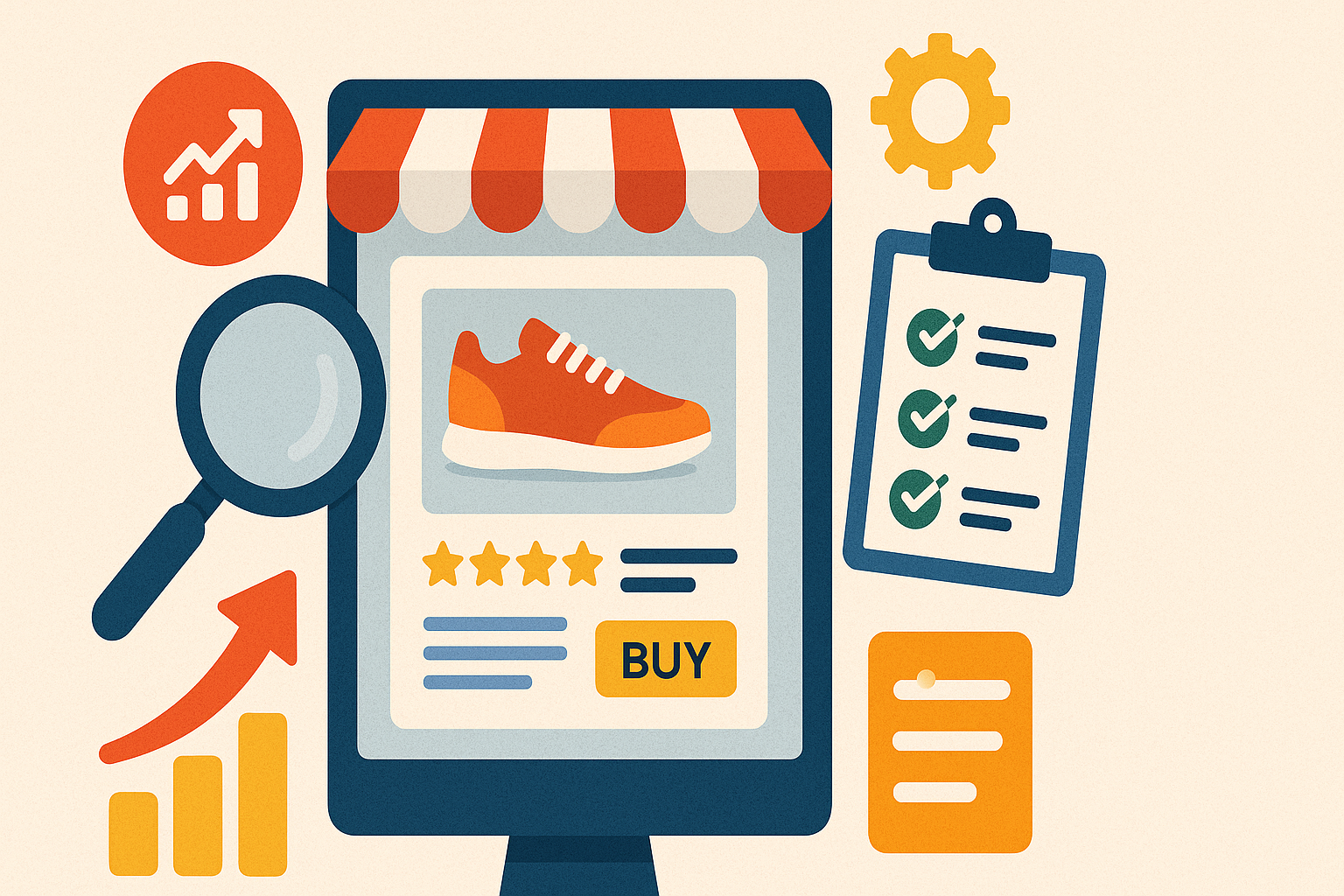Optimising e-commerce product pages is key to transforming casual browsers into buyers. From improving visibility in search engine results to increasing conversion rates and customer satisfaction, every element of your product page matters.
In this guide, we’ll explore why optimising product pages is critical for e-commerce success – and how you can start seeing better results across your entire website. As e-commerce specialists, britweb helps online stores perform better with well-designed, optimised product pages that appeal to their target customers.
If you’re ready to achieve long-term success with your e-commerce website, get in touch with our experienced team today.
What is e-commerce product optimisation?
E-commerce product optimisation refers to improving every element of a product page to drive more conversions and make it more discoverable through search engines. This includes everything from writing informative product descriptions and using high-quality product images to applying structured data markup and internal links that guide website visitors through the entire store.
Unlike basic listings, optimised e-commerce product pages are designed to provide clear, comprehensive, and persuasive information to online shoppers, allowing customers to make informed purchasing decisions confidently. It also ensures that search engines can easily understand and rank these pages in search results.
Why product page optimisation matters
Increased visibility in search results
Optimising product pages with relevant keywords and structured data boosts visibility in search engine results. This means your e-commerce store is more likely to attract potential customers actively looking for your products.
A strong SEO strategy using tools like Google Keyword Planner, SEMrush or Ahrefs can help you identify long-tail keywords that match what your target audience is searching for. By incorporating those keywords into your product titles, meta descriptions, and product descriptions, you improve the likelihood of showing up in search engines.
Higher conversion rates
A well-optimised product page isn’t just about getting found – it’s about converting visitors into buyers. Clear calls-to-action, high-quality images showing multiple angles, and detailed product descriptions highlighting key features help encourage customers and drive sales.
When online shoppers land on your e-commerce product pages, they should feel guided, informed, and motivated to complete a purchase. A cluttered, slow-loading, or vague product page could put them off.
Better mobile optimisation
With most online shopping now taking place on mobile devices, mobile optimisation is no longer optional – it’s essential. A fully optimised product page should include responsive design, fast load times, and touch-friendly navigation to ensure a seamless mobile experience.
To improve speed, you can also consider using a Content Delivery Network (CDN) – a system of servers that loads content faster by serving it from locations closer to the user.
Mobile optimisation not only enhances user experience but also contributes to search engine optimisation (SEO), as mobile-friendliness is a ranking factor for Google.
Find out more about britweb’s e-commerce web development services.
Enhanced user experience and customer satisfaction
Optimising product pages helps enhance user experience across your entire e-commerce site. When users can easily find accurate product data and browse different product variants, trust builds, and customer satisfaction improves.
Add to that the power of social proof, such as positive product reviews and user-generated content, and you can exceed customer expectations.

Essential elements of a well-optimised product page
High-quality product images
Product images are the first thing online shoppers see. They should be crisp, load quickly, and show multiple product angles. Include lifestyle photos and, if possible, videos to demonstrate the product’s features in real-life scenarios.
Compelling product titles
A well-optimised title should be clear, descriptive, and include relevant keywords. Where appropriate, incorporate key attributes such as brand, product type, key features, and the variant (size or colour). Avoid vague or overly short titles, as they can miss opportunities to match search queries and inform potential customers.
Informative product descriptions
A good product description does more than describe the item – it sells it. Use persuasive, benefit-led language that answers common questions, explains key features, and includes long-tail keywords to support search engine optimisation.
Including product categories and specifications will help improve the clarity of the listing and boost its relevance in search engine algorithms.
Meta description and structured data
The meta description is the snippet users see in search engine results. Make sure it’s concise, keyword-optimised, and compelling. Structured data markup can be added to your product pages to display enhanced details, such as price, availability, and star ratings, directly in search results. This can improve click-through rates and help search engines better understand each page.
Customer reviews and user-generated content
Featuring detailed reviews, customer feedback, and images from actual buyers builds trust and provides valuable social proof. This content helps potential customers make informed purchasing decisions and supports e-commerce SEO efforts through fresh, relevant content.
Fast load times and technical performance
Use performance tracking tools to monitor page speed and optimise your web server and media assets. A slow page frustrates users and damages search engine rankings. Compress images and minimise scripts to help improve load times.
Internal links and navigation
Use internal links to guide users from category pages to specific product pages and related items. This helps with product discovery and improves the crawlability of your site, enhancing e-commerce SEO.
Common mistakes to avoid
When optimising e-commerce product pages, efforts can fall short if the fundamentals are overlooked. Be sure to avoid these common pitfalls:
- Using generic or outdated content instead of rich, informative product descriptions
- Skipping keyword research, which leads to missed opportunities with long-tail search terms
- Neglecting mobile optimisation and allowing slow-loading images to hurt user experience
- Failing to implement structured data and missing the opportunity to enhance your product listings with rich results in search engines
- Ignoring internal links, reducing both the ease of navigation and SEO value
- Overlooking customer feedback and reviews, which can build trust and influence conversions
Addressing these areas can significantly improve both your user experience and search performance.
Measuring success
To achieve long-term success with e-commerce product optimisation, tracking performance is essential. We use analytics tools to monitor metrics like conversion rates, bounce rates, and click-through rates from search engine results. This process of ongoing performance tracking allows for continuous improvements based on data. We also recommend A/B testing elements like page layouts and calls-to-action to see what drives more sales.
Grow your e-commerce business with britweb
Our agency has both a highly skilled and experienced web development team and a digital marketing team whose expertise can combine to improve the performance of your e-commerce website and product pages. Working with you, we can help you meet and even exceed your business goals, whether you’re a small local business or a large multinational.
Don’t hesitate to contact us to discuss your business and requirements. We’re adept at creating and implementing tailored strategies and are passionate about our clients’ ongoing success.


